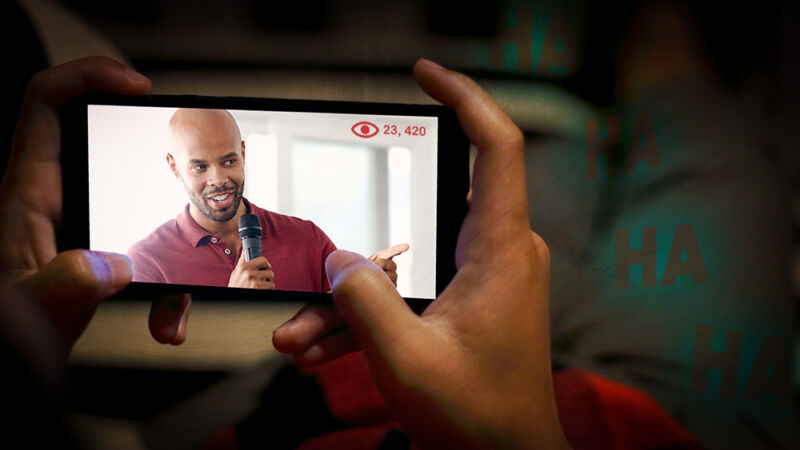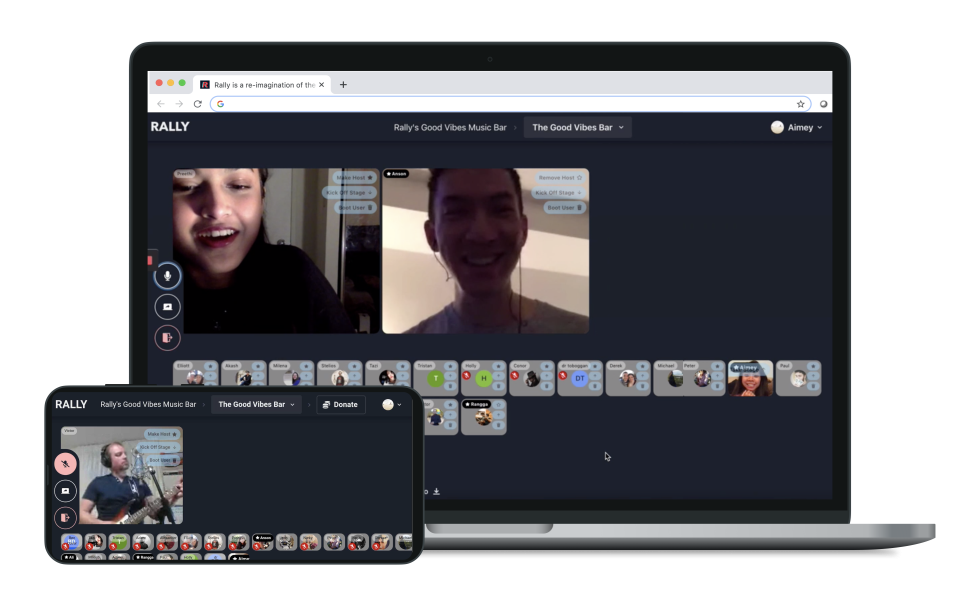
“Was that a stinky DD coming from a big giraffe? It’s definitely not coming from our 14 different pooper dooper locations!”
Moments after stand-up comedian Meg Stalter drops this punchline, as part of a routine mocking the Disney Work Orientation process, her crowd of 11,400 viewers is silent. But she’s not bombing. Stalter is streaming her comedy set via Instagram Live, and as soon as the joke drops, her audience members begin furiously tapping their phone screens, thus sending a wave of pink, yellow, and blue diaphanous hearts up from the right-hand side of her own livestreaming interface.
“I’m about to puke this is so funny,” one fan types. It’s not the immediate feedback of a laughing crowd, but for Stalter, she’ll take it.
Comedy’s current migration patterns
This is live comedy in the COVID-19 era: raucous laughter replaced by hearts, as audiences thousands of miles away tune in. Comedy has migrated to social media, including Instagram Live, Periscope, and Twitch, as well as networking platforms like Zoom. But these millions-strong platforms have something in common: they were never built with the particular nuances of live comedy in mind, and comedians are doing their best to adapt. “I really miss all the energy of performing live, like the laughter,” Stalter admits.
The relief of live, participatory comedy is perfectly suited for something like a pandemic, ripe with awkward interactions and collisions of social norms. Yet it’s one of the few types of performance that require audience reaction to know if the art is working. Most social networks limit their audiences to time-delayed emojis and text messages, while Zoom’s default audio mixing means any mic’ed audience members can disrupt a performer pretty severely.
Stand-up performed to deafening silence is unsettling. When performing live, “there’s an immediate reaction: either it’s funny or it’s not, but [online] you don’t know,” comedian Noah Findling says.
Facebook Live and Instagram Live are trying to make their platforms more interactive, with features that allow performers to bring an audience member into their videos and incorporate live polls, says Addie Coronado, a communications manager at Facebook. Zoom, however, isn’t adding new features that specifically target live performers’ requests, according to a representative. And stand-up comedians in need of a paying gig—and eager to capitalize on entertainment-hungry fans sitting at home—are mostly forced to work within these popular platforms’ constraints instead of expecting fans to jump through hoops like installing or testing brand-new apps.
“A two-way conversation”
That hasn’t stopped enterprising tech-comedy fans from experimenting.
Two months ago, a new platform called Rally debuted with its own ideas on simulating the comedy club experience online, complete with live audience laughter. Rally was launched by three Toronto-based designers with live-performance experience: Ali Jiwani, Amy Liu, and Anson Kao. The idea came about when Jiwani, a comedian, and Liu, a musician, struggled to make money from performing after the COVID-19 crisis hit in March.
“How do we make it easier for everyone who’s just like us to still perform and get their talent out when people aren’t [physically] coming together?” Jiwani says. They also were frustrated with the lack of interactivity on many platforms, which particularly affected live comedy, which is a “two-way conversation,” Liu says. “You can’t just be taking to a screen to a group of muted individuals,” she says.

Within the Rally app, around 15 minutes before the show starts, participants are invited to pick a “seat” in a 2D interface filled with tables and chairs. Viewers can opt into a pre-show video chat with their table neighbors if they want, which is subtly encouraged by the audio of other viewers piped through everyone’s feeds.
Once the show begins, it largely resembles a Zoom video conference, with one major difference: the comedian is center stage, and the audience appears as icons whose voices are audible but at a much lower volume than the comedian. This addresses the default Zoom issue of when a laughing audience member ruins a comedian’s joke by having their face take over the screen. Rally’s current interface also includes moderator tools: if an audience member becomes unruly, a moderator can boot them into a five-minute time-out. If they heckle again, they can be permanently kicked out.
Status update, via crowd banter
Rally’s team says it’s trying to correct another one of the larger issues with live online performances: latency, or the time delay between a joke and the audience laughter. But Rally alleges that its latency is less than a second—that’s roughly the same as Zoom, which can feel like an eternity when a performer relies on the rhythm of punchlines and laughter.
I watched one of the first Rally comedy shows last month, which featured performers in Toronto, San Francisco, and London. The lag wasn’t too bad. I heard the toned-down laughter of other audience members, which didn’t overwhelm the performers’ voices. It wasn’t perfect—one performer’s feed froze and had to be booted mid-act—but there was something great about hearing a comedian ask the audience, “How many of you are single?” and hearing multiple audience members reply, “I am!” in a way that didn’t wrest mic control away from the comedian “on stage.”
A few audience members hung around afterwards to chat with comedians just as they would at a real-life comedy show. It seemed more similar to a comedy club than an Instagram Live show. I felt like I was part of an audience of real people, not of disembodied Instagram handles endlessly tossing up emojis.
Rally’s founders claim they’ve gotten interest from the agents of popular, touring comedians, but the company’s incredibly limited online presence as of press time has us wondering if this experimental platform is built to scale up in a way that performers and audiences alike can easily access. (Cursory searches for “Rally comedy” on search engines and social media tends to bring up stories about political rallies, not a burgeoning live-performance interface.)
The 800 million-pound gorilla
One issue Rally will struggle to surmount is that comedians are flocking to where their audience already is. Facebook’s last major public statement about daily active users came in March 2019, when it estimated a combined 800 million daily users on its Facebook Live and Instagram Live platforms; those numbers have likely grown in the 14 months since.
Some comedians seem to have successfully adapted to these platforms. Stalter, for one, has turned interacting with her audience into an art form. Recently, when she used a livestreamed performance to satirize the Home Shopping Network, Chelsea Peretti (Brooklyn 99) jumped into Stalter’s comments in character to sell the door to her home. “Everybody was commenting to her and not listening to me,” Stalter says, which the comedians were able to play off as a back-and-forth fight over video chat. The bit worked, latency be damned.
Findling has turned to more pre-recorded bits online, although he does some Instagram Live shows as well. “It’d be really helpful to hear the audience [online],” he says, not only because laughter lets him gauge what jokes are working but also because laughter is contagious. “When you have a packed room, it makes people want to laugh more, because they can hear people laughing."
But while Facebook has been bullish on letting users send real-world money to each other via its Messenger app, the company has not yet implemented this system in its livestreamed video platforms—a curious omission, considering they can streamline the money-sending process and get a cut of that pie. “[Comedians on Facebook] are not able to charge [audiences] through ticket sales, but that’s how they make a living,” Rally’s Amy Liu says.
Amazon’s Twitch service is currently in the lead in this department with a range of built-in subscription and donation options, but that popular service has its own fatal flaw: latency. Even an unwieldy Zoom call, full of the laggiest international viewers you can think of, has a quicker audience-response capacity than Twitch’s default, delayed-response system.
It’s hard to imagine this report aging well, honestly. This many months into a pandemic, some performers may very well transition into more frequent livestreamed performances, particularly to tap into the online world’s unlimited crowd sizes, as opposed to cramped comedy clubs. And Hollywood is already eager to snap up the biggest streaming-exclusive hits of the pandemic, with John Krasinski’s Some Good News turning into a CBS exclusive this past week. With momentum like that, a startup like Rally won’t be alone in the space for long.
reader comments
17